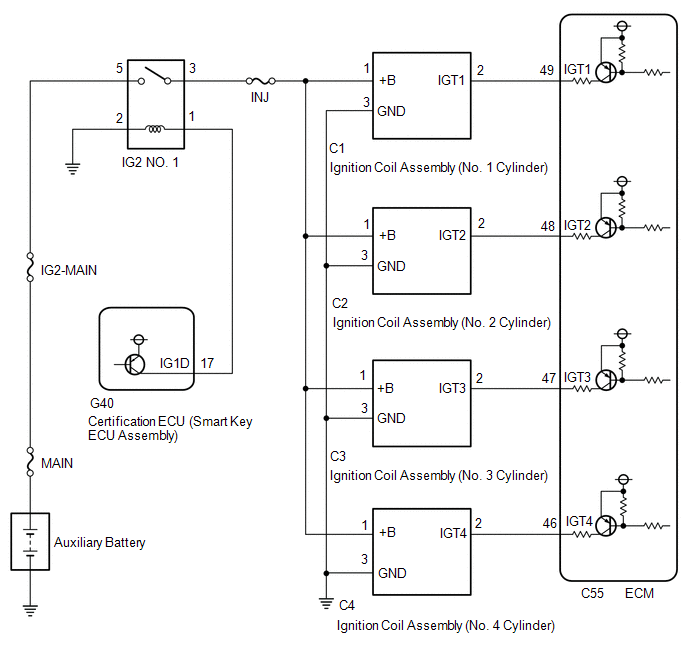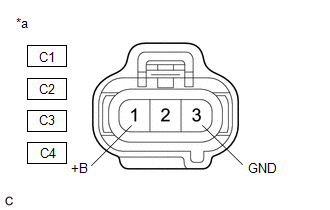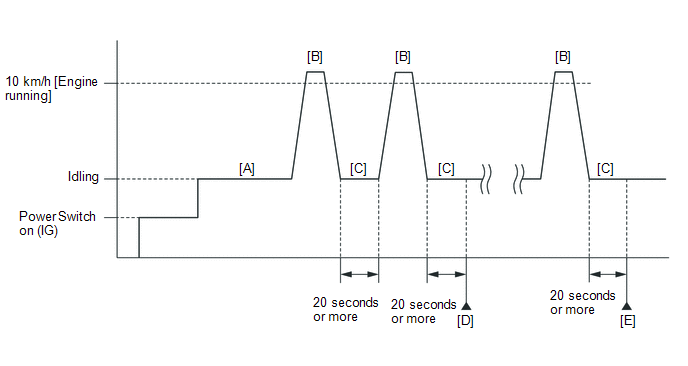Toyota Avalon (XX50): How To Proceed With Troubleshooting. Ignition Circuit. Initialization
How To Proceed With Troubleshooting
CAUTION / NOTICE / HINT
HINT:
*: Use the Techstream.
PROCEDURE
| 1. |
VEHICLE BROUGHT TO WORKSHOP |
|
NEXT |
 | |
| 2. |
CUSTOMER PROBLEM ANALYSIS |
|
NEXT |
 | |
| 3. |
CONNECT TECHSTREAM TO DLC3* |
HINT:
If the display indicates a communication malfunction, inspect the DLC3.
When any CAN communication system DTCs are output, perform troubleshooting for the CAN communication system first.
|
NEXT |
 | |
| 4. |
CHECK DTC AND FREEZE FRAME DATA* |
(a) Check for DTCs.
Powertrain > Engine > Trouble Codes
(b) Check for Freeze Frame Data.
Click here

HINT:
Record or print DTCs and Freeze Frame Data if necessary.
|
NEXT |
 | |
| 5. |
CLEAR DTC AND FREEZE FRAME DATA* |
(a) Clear the DTCs and Freeze Frame Data.
Powertrain > Engine > Clear DTCs
|
NEXT |
 | |
| 6. |
CONDUCT VISUAL INSPECTION |
|
NEXT |
 | |
| 7. |
SELECT CHECK MODE DIAGNOSIS* |
(a) Change the ECM from normal mode to check mode.
Powertrain > Engine > Utility
|
Tester Display |
| Check Mode |
|
NEXT |
 | |
| 8. |
CONFIRM PROBLEM SYMPTOMS |
(a) Confirm the problem symptoms.
HINT:
If the engine does not start, first perform the "Check DTC" procedure and "Conduct Basic Inspection" procedure below.
|
Result | Proceed to |
|
Malfunction does not occur |
A |
| Malfunction occurs |
B |
| B |
 | GO TO STEP 10 |
|
A |
 | |
HINT:
Refer to Symptom Simulation.
Click here 
|
NEXT |
 | |
(a) Check for DTCs.
Powertrain > Engine > Trouble Codes
|
Result | Proceed to |
|
DTCs are output | A |
|
DTCs are not output | B |
| B |
 | GO TO STEP 12 |
|
A |
 | |
HINT:
Refer to Diagnostic Trouble Code Chart.
Click here 
|
NEXT |
 | |
| 12. |
CONDUCT BASIC INSPECTION |
(a) Conduct basic inspection.
Click here 
|
Result | Proceed to |
|
Malfunctioning parts not confirmed |
A |
| Malfunctioning parts confirmed |
B |
| B |
 | GO TO STEP 17 |
|
A |
 | |
| 13. |
REFER TO PROBLEM SYMPTOMS TABLE |
HINT:
Refer to Problem Symptoms Table.
Click here

|
Result | Proceed to |
|
Malfunctioning circuit confirmed |
A |
| Malfunctioning parts confirmed |
B |
| B |
 | GO TO STEP 17 |
|
A |
 | |
| 14. |
CHECK ECM POWER SOURCE CIRCUIT |
(a) Check the ECM power source circuit.
Click here 
|
NEXT |
 | |
| 15. |
CONDUCT CIRCUIT INSPECTION |
|
Result | Proceed to |
|
Malfunction not confirmed |
A |
| Malfunction confirmed |
B |
| B |
 | GO TO STEP 18 |
|
A |
 | |
| 16. |
CHECK FOR INTERMITTENT PROBLEMS |
(a) Check for intermittent problems.
Click here 
|
NEXT |
 | |
| 17. |
CONDUCT PARTS INSPECTION |
|
NEXT |
 | |
|
NEXT |
 | |
|
NEXT |
 | |
| 20. |
CONDUCT CONFIRMATION TEST |
| NEXT |
 | END |
Ignition Circuit
DESCRIPTION
A direct
ignition system is used on this vehicle. The direct ignition system is a
1 cylinder ignition system which ignites one cylinder with one ignition
coil. In the 1 cylinder ignition system, one spark plug is connected to
the end of the secondary winding. High voltage is generated in the
secondary winding and is applied directly to the spark plug. The spark
of the spark plug passes from the center electrode to the ground
electrode.
The ECM determines the ignition
timing and transmits the ignition signals for each cylinder. Using the
ignition signal, the ECM turns on and off the power transistor inside
the igniter, which switches on and off a current to the primary coil.
When the current to the primary coil is cut off, high voltage is
generated in the secondary coil and this voltage is applied to the spark
plugs to create sparks inside the cylinders.
WIRING DIAGRAM

CAUTION / NOTICE / HINT
NOTICE:
Inspect the fuses for circuits related to this system before performing the following procedure.
HINT:
Perform a spark test before proceeding. If there is no spark for any cylinder, inspect this circuit.
Click here 
PROCEDURE
| 1. |
CHECK TERMINAL VOLTAGE (POWER SOURCE OF IGNITION COIL ASSEMBLY) |

|
*a | Front view of wire harness connector
(to Ignition Coil Assembly) |
(a) Disconnect the ignition coil assembly connectors.
(b) Turn the power switch on (IG).
(c) Measure the voltage according to the value(s) in the table below.
Standard Voltage:
|
Tester Connection | Condition |
Specified Condition |
|
C1-1 (+B) - C1-3 (GND) |
Power switch on (IG) |
11 to 14 V |
|
C2-1 (+B) - C2-3 (GND) |
Power switch on (IG) |
11 to 14 V |
|
C3-1 (+B) - C3-3 (GND) |
Power switch on (IG) |
11 to 14 V |
|
C4-1 (+B) - C4-3 (GND) |
Power switch on (IG) |
11 to 14 V |
| NG |
 | GO TO STEP 3 |
|
OK |
 | |
| 2. |
CHECK HARNESS AND CONNECTOR (IGNITION COIL ASSEMBLY - ECM) |
(a) Disconnect the ignition coil assembly connectors.
(b) Disconnect the ECM connector.
(c) Measure the resistance according to the value(s) in the table below.
Standard Resistance:
|
Tester Connection | Condition |
Specified Condition |
|
C1-2 (IGT1) - C55-49 (IGT1) |
Always | Below 1 Ω |
|
C2-2 (IGT2) - C55-48 (IGT2) |
Always | Below 1 Ω |
|
C3-2 (IGT3) - C55-47 (IGT3) |
Always | Below 1 Ω |
|
C4-2 (IGT4) - C55-46 (IGT4) |
Always | Below 1 Ω |
|
C1-2 (IGT1) or C55-49 (IGT1) - Body ground and other terminals |
Always | 10 kΩ or higher |
|
C2-2 (IGT2) or C55-48 (IGT2) - Body ground and other terminals |
Always | 10 kΩ or higher |
|
C3-2 (IGT3) or C55-47 (IGT3) - Body ground and other terminals |
Always | 10 kΩ or higher |
|
C4-2 (IGT4) or C55-46 (IGT4) - Body ground and other terminals |
Always | 10 kΩ or higher |
| OK |
 | REPLACE ECM |
| NG |
 | REPAIR OR REPLACE HARNESS OR CONNECTOR |
| 3. |
CHECK HARNESS AND CONNECTOR (IGNITION COIL ASSEMBLY - BODY GROUND) |
(a) Disconnect the ignition coil assembly connectors.
(b) Measure the resistance according to the value(s) in the table below.
Standard Resistance:
|
Tester Connection | Condition |
Specified Condition |
| C1-3 (GND) - Body ground |
Always | Below 1 Ω |
|
C2-3 (GND) - Body ground | Always |
Below 1 Ω |
| C3-3 (GND) - Body ground |
Always | Below 1 Ω |
|
C4-3 (GND) - Body ground | Always |
Below 1 Ω |
| NG |
 | REPAIR OR REPLACE HARNESS OR CONNECTOR |
|
OK |
 | |
| 4. |
CHECK HARNESS AND CONNECTOR (IG2 NO. 1 RELAY - IGNITION COIL ASSEMBLY) |
(a) Disconnect the IG2 NO. 1 relay from No. 1 engine room relay block and No. 1 junction block assembly.
(b) Disconnect the ignition coil assembly connectors.
(c) Measure the resistance according to the value(s) in the table below.
Standard Resistance:
|
Tester Connection | Condition |
Specified Condition |
|
3 (IG2 NO. 1 relay) - C1-1 (+B) |
Always | Below 1 Ω |
|
3 (IG2 NO. 1 relay) - C2-1 (+B) |
Always | Below 1 Ω |
|
3 (IG2 NO. 1 relay) - C3-1 (+B) |
Always | Below 1 Ω |
|
3 (IG2 NO. 1 relay) - C4-1 (+B) |
Always | Below 1 Ω |
|
3 (IG2 NO. 1 relay) or C1-1 (+B) - Body ground and other terminals |
Always | 10 kΩ or higher |
|
3 (IG2 NO. 1 relay) or C2-1 (+B) - Body ground and other terminals |
Always | 10 kΩ or higher |
|
3 (IG2 NO. 1 relay) or C3-1 (+B) - Body ground and other terminals |
Always | 10 kΩ or higher |
|
3 (IG2 NO. 1 relay) or C4-1 (+B) - Body ground and other terminals |
Always | 10 kΩ or higher |
| OK |
 | GO TO ECM POWER SOURCE CIRCUIT |
| NG |
 | REPAIR OR REPLACE HARNESS OR CONNECTOR |
Initialization
INITIALIZATION
Inspection After Repair
Perform
Learning Value Reset and Idle Learning after replacing or servicing
parts related to engine operation. Details on procedures required are
indicated by an asterisk and a number, and are explained in detail
following the table.
|
Part Replaced | Engine Operation |
Learning Value Reset*1 | Idle Learning*2 |
- Throttle body with motor assembly*3
- Cleaning the deposits from the throttle body with motor assembly*3
| - |
â—‹ | â—‹ |
- Cam timing control motor with EDU assembly
- Removal and installation of a cam timing control motor with EDU assembly
- Camshaft timing gear assembly
- Removal and installation of a camshaft timing gear assembly
| - |
â—‹ | â—‹ |
|
Engine assembly | - |
â—‹ | â—‹ |
- Cylinder head sub-assembly
- Camshaft (for intake or exhaust camshaft)
- Camshaft timing exhaust gear assembly
- Piston or piston ring
- Mass air flow meter sub-assembly
- Port fuel injector assembly
- Direct fuel injector assembly
- Fuel pump (for low pressure side)
- Fuel pump assembly (for high pressure side)
- No. 2 fuel pressure sensor (for low pressure side)
- Fuel pressure sensor (for high pressure side)
- Air fuel ratio sensor (sensor 1)
- Air fuel ratio sensor (sensor 2)
- Engine coolant temperature sensor
- Spark plug
- Ignition coil assembly
- EGR valve assembly
- Air leaks from intake system
- Gas leaks from exhaust system
| Confirm the following and perform Learning Value Reset and Idle Learning when one or more of the following conditions is met:
- A DTC was output before component replacement.
- An air fuel ratio learned value (A/F Learn Value Idle (Port) Bank 1, A/F
Learn Value Low (Port) Bank 1, A/F Learn Value Mid No.1 (Port) Bank 1,
A/F Learn Value Mid No.2 (Port) Bank 1, A/F Learn Value High (Port) Bank
1, A/F Learn Value Idle Bank 1, A/F Learn Value Low Bank 1, A/F Learn
Value Mid No.1 Bank 1, A/F Learn Value Mid No.2 Bank 1, A/F Learn Value
High Bank 1, A/F Learn Value Low (Dual) Bank 1, A/F Learn Value Mid
(Dual) No.1 Bank 1, A/F Learn Value Mid (Dual) No.2 Bank 1 or A/F Learn
Value High (Dual) Bank 1) displayed in the Data List was higher than +/-
20% before component replacement.
- Starting failure or rough idle occurs, or the engine stalls after component replacement.
| â—‹ |
â—‹ |
| The none of the conditions in the list above are met. |
- | - |
|
Knock control sensor*4 |
- | - |
- |
- â—‹: Necessary.
- -: Unnecessary.
NOTICE:
Engine
learned values cannot be reset by disconnecting the cable from the
negative (-) auxiliary battery terminal or removing the EFI-MAIN NO. 4
fuse.
- *1: Learning Value Reset
- Connect the Techstream to the DLC3.
- Turn the power switch on (IG).
- Turn the Techstream on.
- Enter the following menus: Powertrain / Engine / Utility / Learning Value Reset.
- Confirm the following conditions as instructed on the screen.
- - Power switch on (IG)
- - Engine stopped
- - Auxiliary battery voltage is higher than 9 V
- After confirming, select "Next" and initialize the learned value.
HINT:
If
a message indicating learned value initialization failure is displayed
on the screen, confirm the execution conditions, and perform learned
value initialization again.
- After the completion of learned value initialization, confirm the air
fuel ratio learned values (A/F Learn Value Idle (Port) Bank 1, A/F Learn
Value Low (Port) Bank 1, A/F Learn Value Mid No.1 (Port) Bank 1, A/F
Learn Value Mid No.2 (Port) Bank 1, A/F Learn Value High (Port) Bank 1,
A/F Learn Value Idle Bank 1, A/F Learn Value Low Bank 1, A/F Learn Value
Mid No.1 Bank 1, A/F Learn Value Mid No.2 Bank 1, A/F Learn Value High
Bank 1, A/F Learn Value Low (Dual) Bank 1, A/F Learn Value Mid (Dual)
No.1 Bank 1, A/F Learn Value Mid (Dual) No.2 Bank 1 and A/F Learn Value
High (Dual) Bank 1) in the Data List.
If 0% is displayed for all of the air fuel ratio learned values, initialization has completed correctly.
If
a value other than 0% is displayed for one of the air fuel ratio
learned values, perform initialization again. After initialization,
confirm the air fuel ratio learned values. If a value other than 0% is
displayed, replace the ECM.
- *2: Idle Learning
- Turn the power switch off and wait for at least 30 seconds.
- Turn the power switch on (IG).
- Turn the Techstream on.
- Put the engine in Inspection Mode (Maintenance Mode).
Click here 
- Enter the following menus: Powertrain / Engine / Data List / Coolant Temperature.
- Start the engine and warm it up until the engine coolant temperature is 80°C (176°F) or higher.
HINT:
Learning starts when the engine coolant temperature is 80°C (176°F) or higher.
- Turn the power switch off, and then on (READY).
- With the shift lever in P, lightly depress the accelerator pedal to start the engine.
- Wait until the engine stops.
HINT:
The
engine normally stops within 1 minute. However, when the HV battery SOC
is low, the engine may remain running for approximately 3 minutes.
- Enter the following menus: Powertrain / Engine / Data List / ISC Learning.
- Confirm that "Compl" is displayed on the Techstream screen.
- Put the engine in Inspection Mode (Maintenance Mode).
Click here 
- Start the engine.
- Enter the following menus: Powertrain / Engine / Data List / Engine Speed and Engine Independent.
- Check the Engine Speed when the value of Data List item Engine Independent is "Operate".
Standard:
|
Engine Idle Speed |
|
1050 to 1150 rpm |
HINT:
- Be sure to perform this step with the A/C switch and all accessories off.
- Make sure that the shift lever in P.
- If the value of Data List item Engine Independent is "Not Opr" when the
engine is idling, charge control is being performed. Check the Engine
Speed after charge control is complete ("Operate" is displayed).
- *3: Perform Learning Value Reset and Idle Learning after replacing the
throttle body with motor assembly or cleaning deposits from the throttle
body with motor assembly.
After that, check the idle speed. If the idle speed is out of the specified range, perform the following procedure.
CAUTION:
When performing a driving test, obey all speed limits and traffic laws.
HINT:
History information for driving and stopping is necessary to update Idle Learning.

- Turn the power switch on (IG).
- Turn the Techstream on.
- Put the engine in Inspection Mode (Maintenance Mode).
Click here 
- Warm up the engine (engine coolant temperature of 80°C (176°F) or higher) with the A/C switch and all accessories off [A].
- While the engine running, drive the vehicle at a speed of 10 km/h (6 mph) or more [B].
HINT:
If the engine stops, further depress the accelerator pedal to restart the engine.
- Idle the engine for 20 seconds or more [C].
- Repeat procedure [B] and [C].
- Enter the following menus: Powertrain / Engine / Data List / Engine Speed and Engine Independent.
- Check the Engine Speed when the value of Data List item Engine Independent is "Operate" [D].
Standard:
|
Engine Idle Speed |
|
1050 to 1150 rpm |
HINT:
- Be sure to perform this step with the A/C switch and all accessories off.
- Make sure that the shift lever is in P.
- If the value of Data List item Engine Independent is "Not Opr" when the
engine is idling, charge control is being performed. Check the Engine
Speed after charge control is complete ("Operate" is displayed).
- If the idle speed is still out of the specified range, repeat procedure
[B] and [C] until the idle speed is within the specified range [E].
- *4: Drive the vehicle for a short while after replacing the knock
control sensor, and check if knocking occurs. If knocking occurs, drive
the vehicle until knocking stops.














































